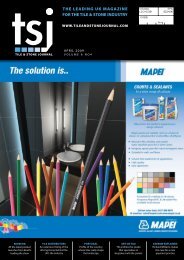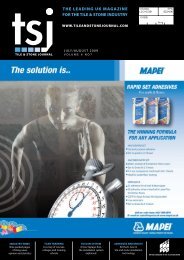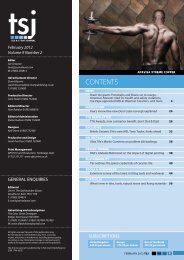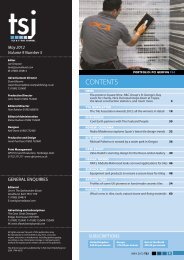Creative Colours - A Spectrum of Inspiration - Tile and Stone Journal
Creative Colours - A Spectrum of Inspiration - Tile and Stone Journal
Creative Colours - A Spectrum of Inspiration - Tile and Stone Journal
Create successful ePaper yourself
Turn your PDF publications into a flip-book with our unique Google optimized e-Paper software.
BARRIER MATTING<br />
The first line <strong>of</strong> defence<br />
TSJ considers some <strong>of</strong> the main options when choosing a<br />
suitable entrance or barrier matting solution for a tiled floor.<br />
Above Sentinel by Shackerley.<br />
Gradus has re-launched two <strong>of</strong><br />
its popular secondary barrier<br />
carpet ranges, upgrading the<br />
performance <strong>and</strong> colour<br />
choices available in the<br />
Boulevard 5000 range, as well<br />
as introducing modern colours<br />
to the Boulevard 6000 range.<br />
Renamed Boulevard 5000HD,<br />
the barrier carpet now<br />
incorporates a light scraper<br />
yarn that has enhanced its<br />
performance in removing dirt<br />
from foot <strong>and</strong> trolley traffic,<br />
plus it’s available in a wider<br />
range <strong>of</strong> eight colours. The<br />
Boulevard 6000 range has also<br />
been re-coloured to provide a<br />
plainer <strong>and</strong> more neutral<br />
palette. Eight colourways are<br />
now available, including three<br />
new additions - Sapphire,<br />
Mocha <strong>and</strong> Nickel - plus five<br />
colours from the previous<br />
collection - Shadow, Rosemary,<br />
Galaxy, Indigo <strong>and</strong> Nightfall.<br />
Both ranges are available in<br />
2m sheet format. Boulevard<br />
6000 is also supplied in 500 by<br />
500mm tiles.<br />
Today’s tile <strong>and</strong> stone market is awash with a plethora <strong>of</strong><br />
cleaning solutions <strong>and</strong> other aftercare ranges. However,<br />
as any housewife will tell you, the most effective cleaning<br />
practice is to stop dirt entering in the first place.<br />
Documented evidence shows that around 80% <strong>of</strong> the dirt<br />
entering a building is taken in on the soles <strong>of</strong> shoes <strong>and</strong> on the<br />
tyres <strong>of</strong> wheeled traffic. When people (or vehicles) pass from<br />
outside to inside a building they bring a mixture <strong>of</strong> dirt, grit <strong>and</strong><br />
moisture. So, unless entrances are protected, they can easily<br />
become slippery <strong>and</strong> hazardous underfoot. Dirt can also quickly<br />
work its way into interior floorcoverings with as much as 1kg<br />
building up in a square metre <strong>of</strong> carpet within 14 days, even in<br />
good weather conditions. Considering the high cost <strong>of</strong> dirt<br />
removal, this is an unnecessary burden on cleaning requirements<br />
<strong>and</strong> maintenance budgets. Moreover, the ingression <strong>of</strong><br />
dirt into textile <strong>and</strong> resilient floorcoverings can lead to scratching<br />
or discolouration <strong>of</strong> the stone or tile surface, <strong>and</strong> also soiling<br />
<strong>of</strong> the grout lines which is where a good proportion <strong>of</strong> the dirt<br />
will inevitably be deposited.<br />
It is thus essential to use an effective entrance flooring system<br />
for the protection <strong>of</strong> internal floors, to reduce the requirement<br />
<strong>of</strong> floor cleaning <strong>and</strong> minimize the risk <strong>of</strong> slipping.<br />
BS 7953: 1999 Entrance Flooring Systems – selection, installation<br />
<strong>and</strong> maintenance, Part 4 states: “The majority <strong>of</strong> soil entering<br />
a building originates from the soles <strong>of</strong> people entering a<br />
building. Other sources are the wheels <strong>of</strong> vehicles, for example,<br />
wheelchairs <strong>and</strong> wind-borne soil. The amount <strong>of</strong> soil brought<br />
into a building varies according to the weather <strong>and</strong> external<br />
conditions, such as building work.<br />
Entrance or barrier matting has several functions. Perhaps the<br />
most obvious is to reduce the incidence <strong>of</strong> slipping accidents<br />
by reducing the amount <strong>of</strong> soil <strong>and</strong> moisture tracked onto the<br />
floor. They also help to prolong the life <strong>of</strong> interior floors by<br />
reducing the ingress <strong>of</strong> soil. This also reduces cleaning requirements.<br />
In order to fulfil these functions, entrance or barrier<br />
matting systems need to remove <strong>and</strong> retain soil, minimise moisture<br />
ingress <strong>and</strong> <strong>of</strong> themselves be simple to clean <strong>and</strong> maintain.<br />
Part 5 <strong>of</strong> BS 7953 states: “The entrance flooring system should<br />
scrape, wipe <strong>and</strong> retain, whilst making contact with both feet <strong>of</strong><br />
people entering the building <strong>and</strong>, in the case <strong>of</strong> wheeled traffic,<br />
with the circumference <strong>of</strong> the wheels.<br />
The Disability Act 1995 also has a major impact on how<br />
entrance matting is to be specified. This is set out in BS 8300:<br />
2001 Building design <strong>and</strong> approach to meet the needs <strong>of</strong> disabled<br />
people – code <strong>of</strong> practice.<br />
Clause 9.1.3 states: “Floor surfaces should be slip resistant to<br />
give a firm foothold <strong>and</strong> good wheel grip under all wet <strong>and</strong> dry<br />
conditions.”<br />
This slip resistance is a vital factor since slips, trips <strong>and</strong> falls are<br />
the most common <strong>of</strong> all work-related accidents Statistics<br />
issued by the UK’s Health & Safety Executive show slipping <strong>and</strong><br />
tripping to be the single most common cause <strong>of</strong> injuries in the<br />
UK workplace. In 2005/2006, slips <strong>and</strong> trips represented 36% <strong>of</strong><br />
the total number <strong>of</strong> reported major injuries in the workplace<br />
<strong>and</strong>, <strong>of</strong> this figure, 19% involved slipping on a wet substance or<br />
surface.<br />
As well as days lost through sickness following falls, employers<br />
also face the growing risk <strong>of</strong> litigation.<br />
In the UK slips <strong>and</strong> trips accounted for 698,336 hospital bed<br />
days in 2002/03. In contrast, accidents involving car occupants<br />
accounted for only 82,395.<br />
These worrying facts, combined with an increased awareness<br />
about public liability, means that it is vital to get the entrance<br />
matting specification - a building’s first line <strong>of</strong> defence - right<br />
from the outset.<br />
Selected Suppliers<br />
Plastic Extruders <strong>of</strong>fers a range <strong>of</strong> entrance solutions for locations<br />
where water may be present <strong>and</strong> where there is a need to<br />
maintain safe <strong>and</strong> hygienic conditions, especially in public<br />
places such as jetties, around swimming pools, in shower rooms<br />
<strong>and</strong> in changing areas. For barefoot <strong>and</strong> wet areas they include<br />
Heronrib, Herontile <strong>and</strong> Heronair.<br />
The company’s high performance entrance flooring systems<br />
will prevent dirt from entering buildings, keep shoes clean <strong>and</strong><br />
effectively reduce cleaning <strong>and</strong> maintenance costs. The company<br />
recommends the Frontrunner range, this includes Brush,<br />
Matting <strong>and</strong> Module options, plus Frontrunner Plus <strong>and</strong><br />
Frontrunner XT.<br />
3m’s Nomad Aqua 6500 Floor Mats remove dirt <strong>and</strong> absorb<br />
moisture. They are suitable for medium traffic volumes <strong>of</strong><br />
between 500 <strong>and</strong> 1,500 crossings per day. They feature dual<br />
fibre construction for long lasting performance.<br />
Construction Specialties‘ entrance flooring range, Pedisystems, has<br />
been used for projects large <strong>and</strong> small, across a spectrum <strong>of</strong><br />
business sectors including healthcare, education, commercial,<br />
retail, transport <strong>and</strong> leisure. The company operates a Quality<br />
Management System complying with BS EN ISO 9001:2000.<br />
Jaymart’s Raincheck is a super-heavy contract quality, extra<br />
absorbent, deep nylon brush-on-vinyl backing, clean zone barrier<br />
matting/foyer carpeting. 8.5mm thick, it is specially manufactured<br />
for heavily trafficked areas. It combines maximum<br />
42 TSJ JUNE 2010












